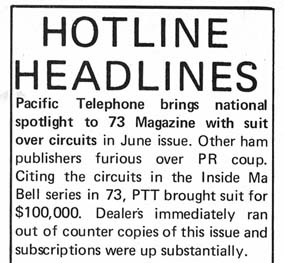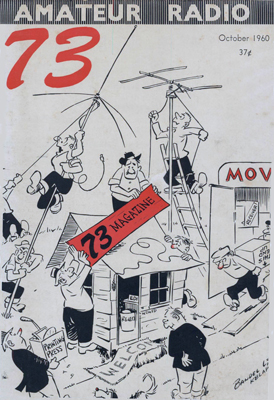After
5 years as editor of CQ magazine, Wayne Green wanted to start his own amateur
radio magazine. He could not find investors so he sold 2 Porsches, a boat, an
airplane and his Arabian horse to start 73. At first the staff was Wayne and his
wife Virginia. The first issue of 73 Amateur Radio was October 1960 and it sold
for 37 cents.
The original office was the Green's apartment in Brooklyn, New York. In July 1962 the magazine moved to Peterborough, New Hampshire. Wayne and Virginia
were divorced in 1965. In December 1974 Virginia Londner Green was back as
Business Manager of 73 Inc.

In each issue Wayne Green would write his "Never Say Die" editorial. These would
cover a wide range of topics and could go on for 5 or 6 pages. (Today, this
would be an internet blog.) A popular item was Wayne's
railing against
authority. It could be the old line amateur radio organization (ARRL), the FCC,
the phone company or the government. In 1974 he was at war with the IRS, every
issue from January to July gave accounts of the evils of the IRS. The July issue
gave the news that Wayne lost and was convicted of tax fraud. The sentence was
suspended. Another
famous battle was with the phone company. The June 1975 issue had an
article "Inside Ma Bell" by "Spenser Whipple Jr." and it
had details on how to build a "Black Box", "Red Box", and the infamous "Blue
Box", all devices intended to defraud the phone company. Another
famous battle was with the phone company. The June 1975 issue had an
article "Inside Ma Bell" by "Spenser Whipple Jr." and it
had details on how to build a "Black Box", "Red Box", and the infamous "Blue
Box", all devices intended to defraud the phone company.
The phone company settled with 73 Inc in January 1976. (Spenser Whipple Jr.,
Wayne Green, Virginia Londner Green and 200 John/Jane Does.) All issues of
the offending 73 Magazines had to be destroyed including those at public
libraries. They also had to notify each subscriber and tell them to destroy the
June issue. (Most subscribers ignored that and made Xerox copies to give to
their friends.)
Wayne promoted the use of new technology in amateur radio. Some of the
construction articles in 73 were using elaborate digital logic designs and the
microprocessor was showing up in hobbyist kits. By 1975 the magazine was
prospering and Wayne was looking for new magazine ideas. On May 25, 1975 Wayne
and Virginia made a deal with Carl Helmers to be the editor BYTE magazine. The
first issue was dated September 1975, but came out on August 6. (Magazines
normally come out a week or two before the cover date, but Wayne could push that
to a month early.)
For some reason BYTE was not published by 73 Inc, but by Green Publishing
(incorporated on March 7, 1975). For
the first four issues Wayne Green was listed as the publisher. The January 1976 issue
listed Virginia Londner Green as the publisher. The
February issue had an
article titled "Our New Office" with a cryptic account of how BYTE moved into a
separate building. In a January 1985 interview, Wayne Green relates that when he
arrived at the office one day in November 1975, when the January issue was in
the works, he found that everything had been moved out.
There was a legal battle but Virginia kept BYTE magazine. In response Wayne
started a new computer magazine in January 1977. Kilobaud was successful and
lead to a group of computer specific magazines such as 80 Microcomputing
targeting users of the TRS-80 computer
Virginia Londner and Carl Helmers sold Byte Publishing to McGraw-Hill in April
1979 for a reported 2 to 3 million dollars.
Wayne Green sold his publishing business to CW Communications in June 1983 for a lot of
cash.
In March 1986 Wayne Green reacquired 73 magazine and continued publishing it until
September 2003. |
 The
first issue of 73
The
first issue of 73
 Another
famous battle was with the phone company. The June 1975 issue had an
article "
Another
famous battle was with the phone company. The June 1975 issue had an
article "